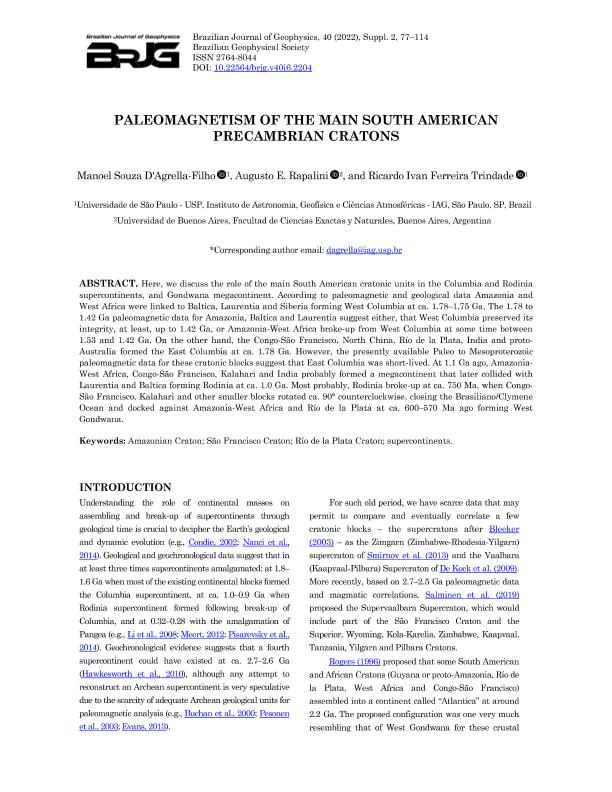Artículo
Paleomagnetism of the Main South American Precambrian Cratons
Fecha de publicación:
03/2022
Editorial:
Sociedade Brasileira de Geofisica
Revista:
Brazilian Journal of Geophysics
ISSN:
2764-8044
Idioma:
Inglés
Tipo de recurso:
Artículo publicado
Clasificación temática:
Resumen
Here, we discuss the role of the main South American cratonic units in the Columbia and Rodinia supercontinents, and Gondwana megacontinent. According to paleomagnetic and geological data Amazonia and West Africa were linked to Baltica, Laurentia and Siberia forming West Columbia at ca. 1.78-1.75 Ga. The 1.78 to 1.42 Ga paleomagnetic data for Amazonia, Baltica and Laurentia suggest either, that West Columbia preserved its integrity, at least, up to 1.42 Ga, or Amazonia/West Africa broke-up from West Columbia at some time between 1.53 and 1.42 Ga.. On the other hand, the Congo/São Francisco, North China, Rio de la Plata, India and proto-Australia formed the East Columbia at ca. 1.78 Ga. However, the presently available Paleo to Mesoproterozoic paleomagnetic data for these cratonic blocks suggest that East Columbia was short-lived. At 1.1 Ga ago, Amazonia/West Africa, Congo-São Francisco, Kalahari and India probably formed a megacontinent that later collided with Laurentia and Baltica forming Rodinia at ca. 1.0 Ga. Most probably, Rodinia broke-up at ca. 750 Ma, when Congo/São Francisco, Kalahari and other smaller blocks rotated ca. 90° counterclockwise, closing the Brasiliano/Clymene ocean and docked against Amazonia/West Africa and Rio de la Plata at ca. 600-570 Ma ago forming West Gondwana.
Archivos asociados
Licencia
Identificadores
Colecciones
Articulos(IGEBA)
Articulos de INSTITUTO DE GEOCIENCIAS BASICAS, APLICADAS Y AMBIENTALES DE BS. AS
Articulos de INSTITUTO DE GEOCIENCIAS BASICAS, APLICADAS Y AMBIENTALES DE BS. AS
Citación
Souza D'Agrella Filho, Manoel; Rapalini, Augusto Ernesto; Ferreira Da Trindade, Ricardo Ivan; Paleomagnetism of the Main South American Precambrian Cratons; Sociedade Brasileira de Geofisica; Brazilian Journal of Geophysics; 40; 3-2022; 77-114
Compartir
Altmétricas




